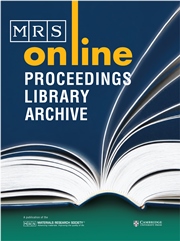Article contents
Chemically Bonded Ceramics as an Alternative to High TemperatureComposite Processing
Published online by Cambridge University Press: 21 February 2011
Abstract
Processing of multi-phase ceramic composite materials using chemicallybonded ceramics as a binding agent appears to be a promising route forfabricating complex-shaped structures. In a zirconia-calcium aluminateceramic matrix composite, the hydraulic property of fine, monocalciumaluminate (CaAl2O4) powders was used to prepare strongprefired bodies.
The changes in the physical characteristics of the composite during theconversion from a chemically bonded compact into a sintered composite werestudied using thermogravimetric analyses (TGA), X-ray diffraction andscanning electron microscopy. The density and the hardness of the chemicallybonded and sintered composite were measured.
Information
- Type
- Research Article
- Information
- Copyright
- Copyright © Materials Research Society 1998
References
REFERENCES
- 6
- Cited by

